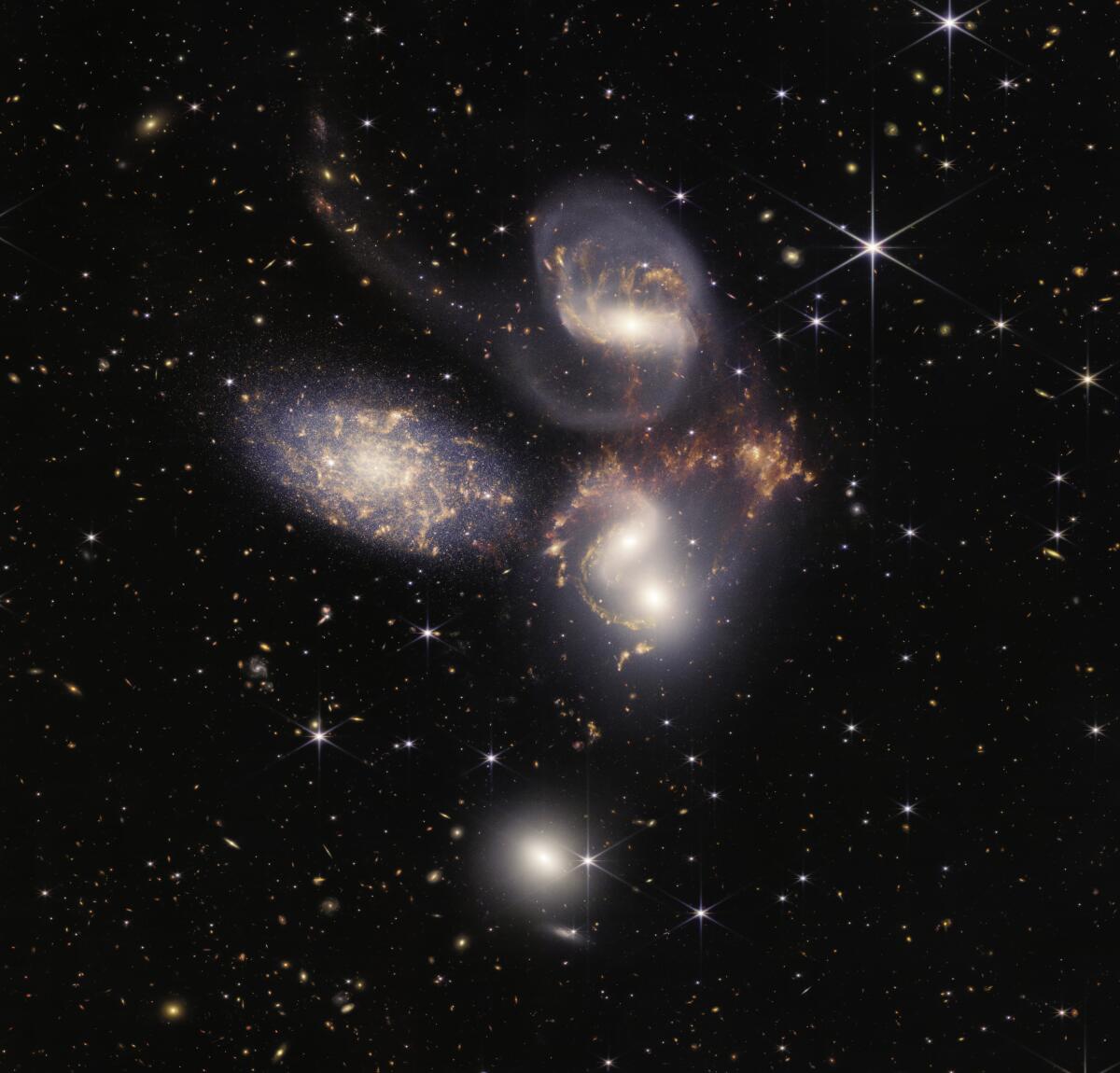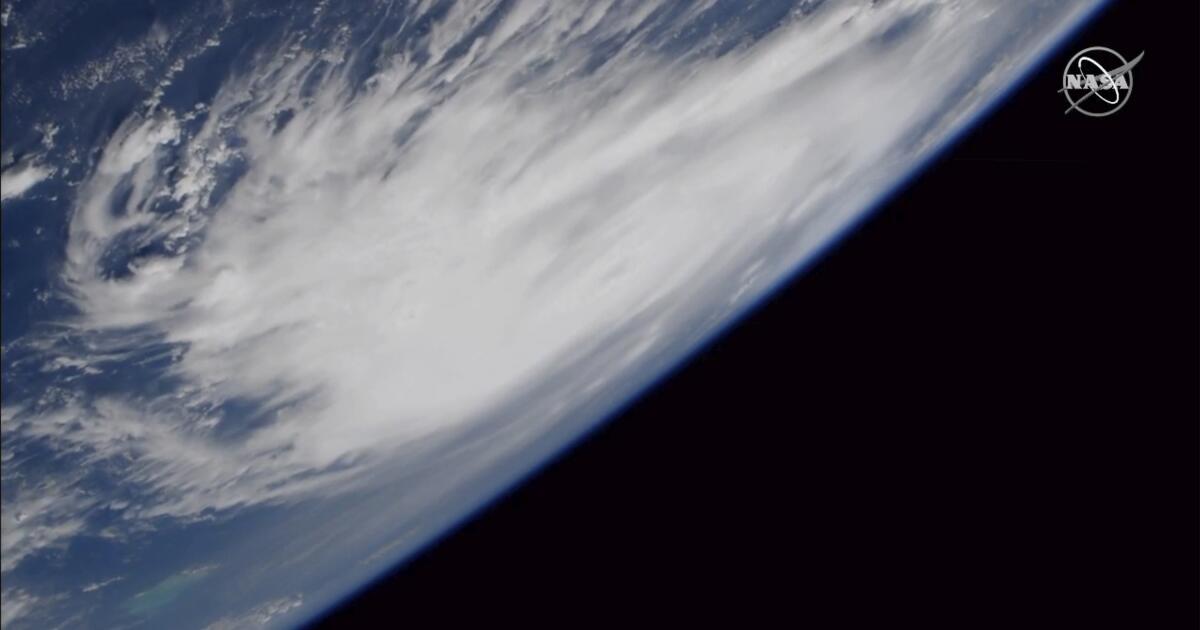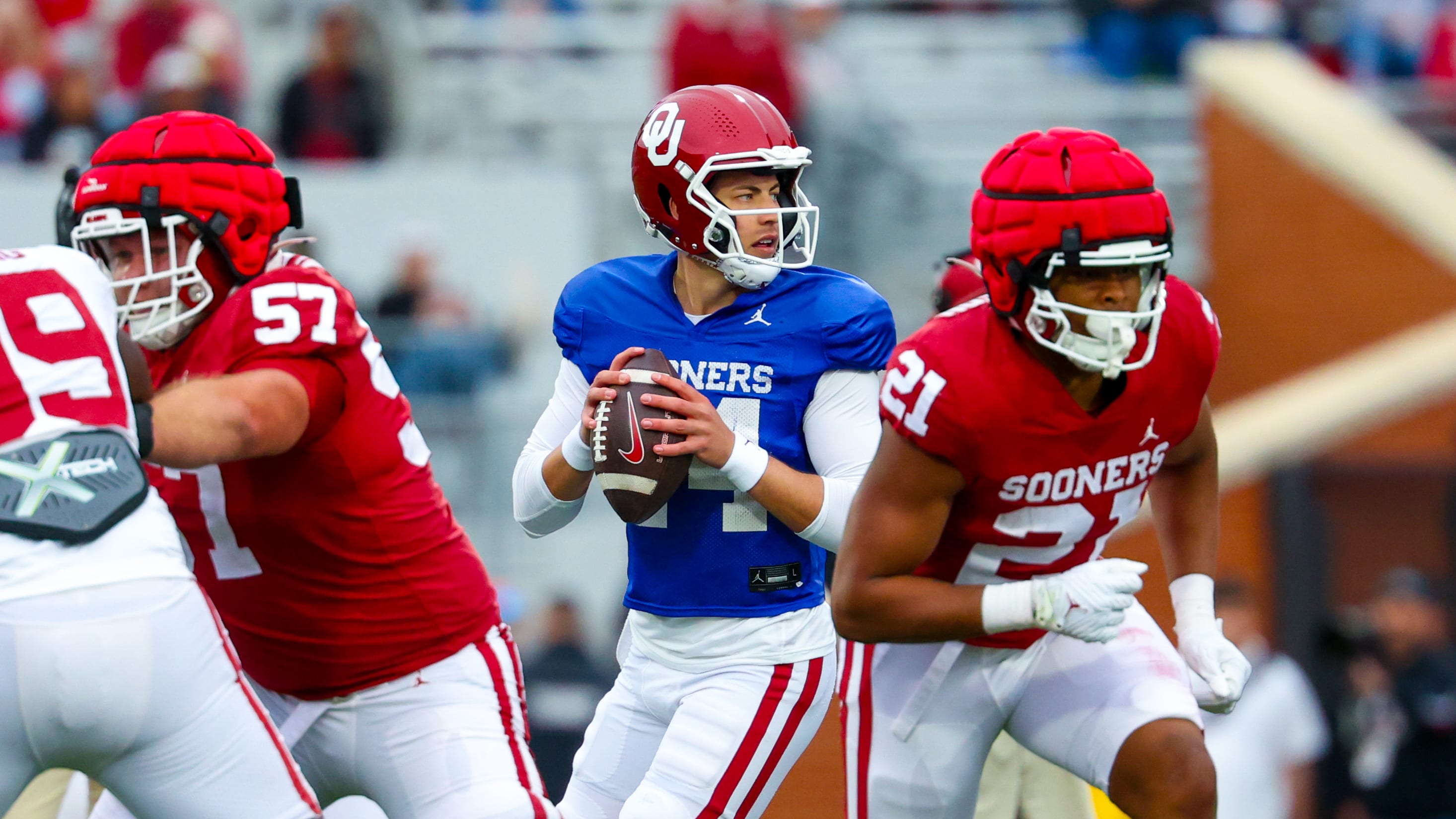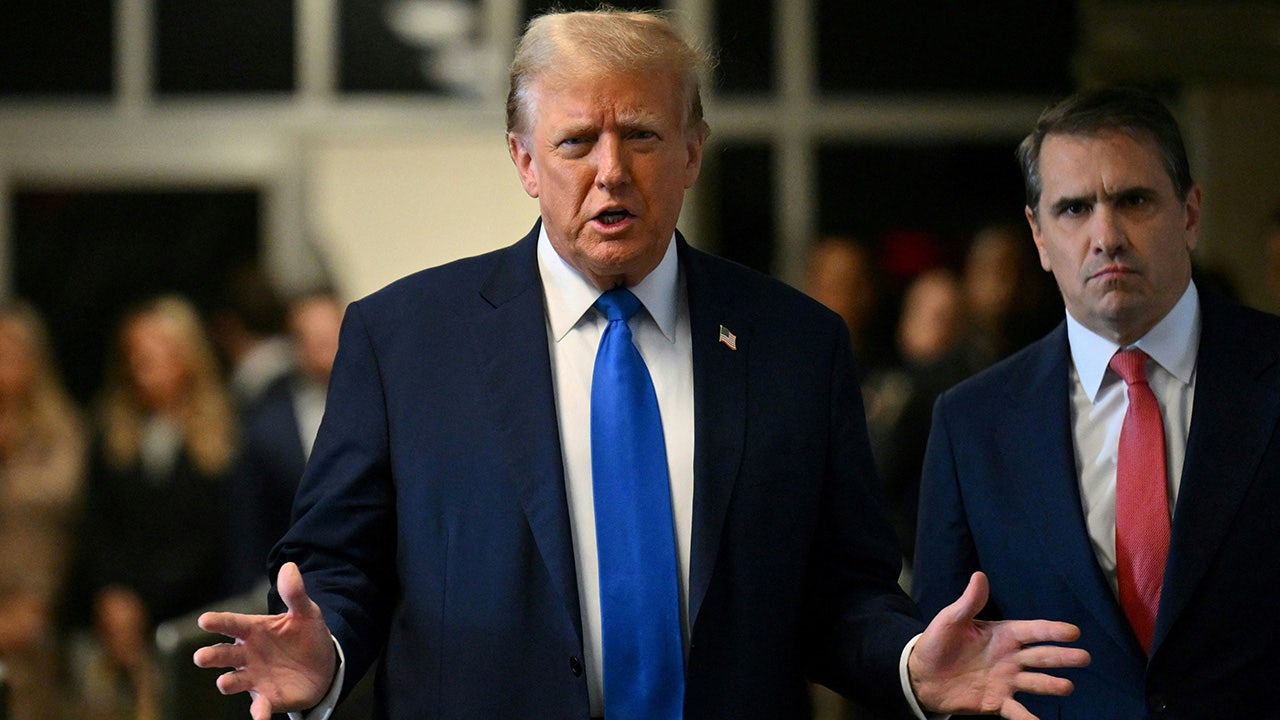Science
NASA's attempt to bring home part of Mars is unprecedented. The mission's problems are not

Massive cost overruns. Key deadlines slipping out of reach. Problems of unprecedented complexity, and a generation’s worth of scientific progress contingent upon solving them.
That’s the current state of Mars Sample Return, the ambitious yet imperiled NASA mission whose rapidly ballooning budget has cost jobs at NASA’s Jet Propulsion Laboratory in La Cañada Flintridge and drawn threats of cancellation from lawmakers.
But not all that long ago, those same dire circumstances described the James Webb Space Telescope, the pioneering infrared scope that launched on Christmas Day 2021.
The biggest space telescope ever has so far proved to be a scientific and public relations victory for NASA. The telescope’s performance has surpassed all expectations, senior project scientist Jane Rigby said at a meeting recently.
Its first images were so hotly anticipated that the White House scooped NASA’s announcement, releasing a dazzling view of thousands of galaxies the day before the space agency shared the first batch of pictures. Thousands of researchers have since applied for observation time.
“The world has been rooting for this telescope to succeed,” Rigby told the National Academies’ committee on astronomy and astrophysics.
Yet in the years before launch, the success and acclaim Webb now enjoys were far from guaranteed.
The telescope cost twice as much as initially anticipated and launched seven years behind its original schedule. Some members of Congress at one point tried to pull funding from the project. Even the journal Nature referred to it at the time as the “telescope that ate astronomy.”
After a thorough assessment of the project’s needs and flaws, NASA was able to turn the troubled venture around. Supporters of Mars Sample Return are hopeful that mission will follow a similar trajectory.
“A lot of great science will come out of” Mars Sample Return, said Garth Illingworth, an astronomer emeritus at UC Santa Cruz and former deputy director of the project that is now the James Webb Space Telescope. “But they’ve got to get real as to how to manage this.”
Last year was a crisis point for Mars Sample Return, whose goal is to fetch rocks from the Red Planet’s Jezero crater and bring them back to Earth for study.
In July, the U.S. Senate presented NASA with an ultimatum in its proposed budget: Either present a plan for completing the mission within the $5.3 billion budgeted, or risk cancellation. A sobering independent review found in September that there was “near zero probability” of Mars Sample Return making its proposed 2028 launch date, and “no credible” way to fulfill the mission within its current budget. NASA is due to respond to that report this month.
These tubes hold samples of rock cores and regolith (broken rock and dust) collected by NASA’s Perseverance rover for the Mars Sample Return campaign, which aims to bring bits of Mars back to Earth for closer study.
(NASA / JPL-Caltech / MSSS)
The James Webb Space Telescope was further along in its development journey when it reached a similar crossroads in 2010, six years after construction began. Frustrated with the ballooning budget and constantly postponed launch date, the U.S. House of Representatives included no funding for the telescope in its proposed budget, which would have ended the project had the Senate agreed.
In a statement, lawmakers castigated the mission as “billions of dollars over budget and plagued by poor management,” foreshadowing the criticisms that would be leveled at Mars Sample Return more than a decade later.
To forestall cancellation, Sen. Barbara Mikulski (D-Md.) ordered an independent review of the project, which was under construction in her state.
The board determined that Webb’s problems stemmed from a “badly flawed” initial budget. All the technical expertise needed to complete this ambitious project was there, the evaluators concluded. But getting it done with the amount of money currently set aside would be virtually impossible.
Illingworth remembered that review when he read the Mars Sample Return assessment, which offered a similarly stark conclusion.
“Some of the words are very familiar,” he said with a chuckle.
When the Mikulski review came out in 2010, Illingworth was deputy director of the Space Telescope Science Institute, which now leads science and operations for the James Webb Space Telescope.

With its powerful infrared vision and extremely high spatial resolution, the James Webb Space Telescope shows never-before-seen details in an image mosaic of the galaxy group known as Stephan’s Quintet.
(Space Telescope Science Institute / NASA, ESA, CSA, STScI, Webb ERO)
He was sympathetic to the challenges facing Mars Sample Return managers, though chagrined that the James Webb Space Telescope’s hard-earned lessons have apparently faded so quickly — especially the importance of having a realistic budget from the beginning.
NASA missions are managed by very smart people with established histories of doing very hard things. How does something as terrestrially mundane as budgeting continually trip them up?
“The problem is that the models that you have as a cost estimator — and they have very complex proprietary software models that attempt to understand these types of things — are all built on things that have happened, in the past tense,” said Casey Dreier, chief of space policy for the Planetary Society.
“By definition, when you’re trying something completely new, it’s very hard to estimate in advance how much something unprecedented will cost,” Dreier said. “That happened for Apollo, that happened for the space shuttle, it happened for James Webb, and it’s happening now for Mars Sample Return.”
Mars Sample Return also has some mission-specific challenges that Webb didn’t have to contend with. For one, it’s happening at the same time as Artemis, NASA’s wildly expensive mission to return people to the moon.
Expected to cost $93 billion through 2025, Artemis got a 27% increase in its budget over the previous year, while Mars Sample Return’s guaranteed funding is 63% less than last year’s spend.
And while NASA’s ambitions are growing, its funding from Congress, adjusted for inflation, has been essentially flat for decades. That leaves little room for unexpected extras.
“We are tasking the space agency with the most ambitious slate of programs in space since the Apollo era, but instead of Apollo-era budgets, it has one-third of 1% of U.S. spending to work with,” Dreier said. “If you stumble right now, the wolves will come for you. And that’s what is happening to Mars Sample Return.”
Not all ambitious scientific endeavors survive the kind of scrutiny the sample return is facing. In 1993 Congress canceled the U.S. Department of Energy’s Superconducting Super Collider, an underground particle accelerator, citing concerns about rising costs and fiscal mismanagement. The government had already spent $2 billion on the project and dug 14 miles of tunnel.
But in the same week that Congress ended the supercollider, it agreed — by a margin of a single vote — to continue funding the International Space Station, a similarly expensive project whose cost overruns had been widely criticized. ISS launched in November 1998 and is still going strong. (For now, anyway — NASA will intentionally crash it into the sea in 2030.)
The space station’s future was never seriously threatened again after that painfully close vote, just as Webb’s future was never seriously questioned after the 2010 cancellation threat.
JPL, the institution managing Mars Sample Return, has already paid dearly for the mission’s initial stumbles, laying off more than 600 employees and 40 contractors after NASA ordered it to reduce its spending.
But projects that survive this kind of reckoning often emerge “stronger and more resilient,” Dreier said. “They know the eyes of the nation and NASA and Congress are on them, so you have to perform.”
NASA is set to reveal this month how it plans to move forward with Mars Sample Return. Those familiar with the mission say they believe it can still happen — and that it’s still worth doing.
“Do I have faith in NASA, JPL, all of those involved to be able to deliver on the Mars Sample Return mission with the attention and technical integrity that it requires? Absolutely,” said Orlando Figueroa, chair of the the mission’s independent review team and NASA’s former “Mars Czar.”
“It will require very difficult decisions and levels of commitment, including from Congress, NASA and the administration, [and] a recognition of the importance, just like was the case with James Webb, for what this mission means for space science.”

Science
To save Black lives, panel urges regular mammograms for all women ages 40 to 74

To counteract growing rates of breast cancer in younger women and to reduce racial disparities in deaths, an influential panel has changed its advice and is urging most women to begin getting regular mammograms at age 40.
The new recommendations from the U.S. Preventive Services Task Force say women without genetic mutations that make it extremely likely they will develop breast cancer should get their first mammogram to screen for the disease at age 40 and should continue with the exams every other year until they turn 74. The guidelines were published Tuesday in the Journal of the American Medical Assn.
Breast cancer is one of the most common cancers among women in the U.S., as well as one of the deadliest. An estimated 297,790 U.S. women were diagnosed with the disease last year, and 43,170 died of it, according to the American Cancer Society.
The task force, a group of 16 experts convened by the federal government, sparked an uproar 15 years ago when it said women could wait until 50 to begin regular, biennial breast cancer screening — much later and less frequent than what other medical groups were recommending at the time. The group’s rationale was that women in their 40s faced a low risk of breast cancer and that frequent testing of asymptomatic women in this age group caused too many to endure biopsies and other invasive procedures that were unnecessary and potentially dangerous.
The task force reaffirmed its controversial position in 2016. But when the time came to update its guidelines again, two facts stood out.
First, the incidence of invasive breast cancer in younger women, which had been slowly climbing since at least 2000, began to accelerate around 2015, rising by an average of 2% per year over the following four years.
Second, the task force recognized that among all racial and ethnic groups, Black women are most likely to be diagnosed with breast cancers that have progressed beyond stage 1, including the aggressive “triple negative” tumors that are particularly difficult to treat. Black women also have the highest mortality rate from breast cancer — about 40% higher than that of white women — “even when accounting for differences in age and stage at diagnosis,” the task force wrote in JAMA.
After analyzing data from randomized clinical trials and models based on real-world data, the panel determined that starting biennial mammograms at 40 instead of 50 would prevent an additional 1.3 breast cancer deaths per 1,000 women over the course of their screening lifetimes. For Black women, starting a decade earlier would avert an additional 1.8 deaths per 1,000 women.
“This is a big change, absolutely,” said Dr. Stamatia Destounis, chair of the American College of Radiology Commission on Breast Imaging. “We all realize that if you start to screen a woman at 40, you’re going to find the most cancers.”
Robert Smith, the American Cancer Society’s senior vice president for early cancer detection science, said the task force’s new guidance is more in line with advice from other medical organizations, including his own.
“We don’t want any woman to have a breast cancer diagnosed late if it can be avoided,” Smith said. “There’s no substitute for finding a breast cancer sooner in its natural history.”
But Ricki Fairley, founder and chief executive of Touch, the Black Breast Cancer Alliance in Annapolis, Md., said that if the goal is to reduce racial disparities, screening starting at age 40 isn’t nearly enough.
“I’m dealing with patients right now that are 24, 23, and are having breast cancer and dying,” said Fairley, a breast cancer survivor who was diagnosed at age 55. “Getting a first mammogram at age 40 is way too late for Black women.”
Reonna Berry, president and co-founder of the African American Breast Cancer Alliance in Minneapolis, criticized the task force for sticking with its advice to screen every other year.
“If we waited every two years to get a mammogram, a lot of Black women would be dead,” said Berry, who was diagnosed with breast cancer at 38 and again a few years ago, in her late 60s.

A radiologist reviews a mammogram at UCLA.
(Jay L. Clendenin / Los Angeles Times)
The American College of Radiology and the Society of Breast Imaging recommend annual screening starting at 40. The American Cancer Society recommends annual screenings for 45- to 54-year-olds, then screening every year or two after that. In addition, the ACR advises Black women to conduct a risk assessment and devise a screening strategy with a doctor when they are 25, Destounis said.
Smith said that although Black women under 40 are more likely than their white counterparts to be diagnosed with breast cancer, the difference isn’t large enough to warrant widespread screening.
According to data gathered by the National Cancer Institute, there are 38 breast cancer cases per 100,000 Black women between the ages of 30 and 34, compared with 32.3 cases per 100,000 white women in the same age group. For women ages 35 to 39, the respective figures are 74.8 and 69.2. In both age groups, that amounts to fewer than 6 additional breast cancers per 100,000 women.
Smith and others criticized the task force for failing to endorse screening mammograms for women over 74. As in years past, the panel determined there wasn’t enough evidence to make a recommendation one way or another.
“At the age of 75, the risk of breast cancer is very high,” Smith said.
There are 473.2 cases per 100,000 women of all racial and ethnic backgrounds between the ages of 75 and 79, and 425.8 cases for ages 80 to 84, the National Cancer Institute reports.
“There’s no reason, at least in our judgment, that women should stop screening as long as they’re in good health and expect to live another 10 years,” Smith said.
Dr. John B. Wong, a vice chair of the task force, said the lack of evidence regarding mammograms for older women is “totally frustrating.”
There are no randomized clinical trials with women in this age group, but the panel did consider a cohort study of more than 1 million Medicare patients that found no benefit to screening women ages 75 to 84, Wong said.
The situation was similar regarding the use of ultrasound or MRI as supplemental screening tools for women with dense breasts, he said.
“We know that they’re at increased risk, and we know mammography doesn’t work as well for them,” Wong said. “We would love to have some evidence to help us decide what to recommend about what they should do.”
On the question of screening frequency, the task force had enough data to act. With biennial screening between the ages of 40 and 74, there will be about 1,376 false-positive results per 1,000 women over their lifetimes, along with 14 instances of doctors finding and treating early-stage tumors that might never have become dangerous if left alone. Both would increase by about 50% if women were screened annually, Wong said.
The panel concluded that screening every other year prevents more deaths and results in more years of life gained per mammogram, producing a better balance of benefits and harms.
Dr. Julie Gralow, chief medical officer for the American Society of Clinical Oncology, said she would weigh those trade-offs differently.
“As a breast cancer doctor, I’m on the receiving end of everybody who’s diagnosed, and I think they way overplayed the harms versus the benefits,” she said, particularly the anxiety that would stem from being asked to come in for follow-up imaging. “I know for some women that’s very scary and all, but it’s almost a paternalistic kind of view.”
That notion was echoed by Karen Eubanks Jackson, founder and CEO of Sisters Network, a national breast cancer organization for Black women.
“We understand that having too many mammograms can sometimes not be in your favor,” said Jackson, a breast cancer survivor. “But as a Black woman having had it four times, I’d rather be false positive than be positive and not know it. Give me my choice.”
Gralow emphasized that the task force recommendations do not apply to women with any kind of breast abnormality.
“If you have any symptom, then you should go straight to diagnostics, and that should be done at any age,” she said.
In Smith’s ideal world, precision medicine would allow doctors to replace broad guidelines with individualized screening recommendations based on the information in each woman’s health records.
“They might say, ‘Start screening at an earlier age’ or ‘Screen every year’ or ‘You can go every other year, and that’s just as safe,’ ” Smith said. “The sooner we move in that direction, the better.”
Science
Canny as a crocodile but dumber than a baboon — new research ponders T. rex's brain power

In December 2022, Vanderbilt University neuroscientist Suzana Herculano-Houzel published a paper that caused an uproar in the dinosaur world.
After analyzing previous research on fossilized dinosaur brain cavities and the neuron counts of birds and other related living animals, Herculano-Houzel extrapolated that the fearsome Tyrannosaurus rex may have had more than 3 billion neurons — more than a baboon.
As a result, she argued, the predators could have been smart enough to make and use tools and to form social cultures akin to those seen in present-day primates.
The original “Jurassic Park” film spooked audiences by imagining velociraptors smart enough to open doors. Herculano-Houzel’s paper described T. rex as essentially wily enough to sharpen their own shivs. The bold claims made headlines, and almost immediately attracted scrutiny and skepticism from paleontologists.
In a paper published Monday in “The Anatomical Record,” an international team of paleontologists, neuroscientists and behavioral scientists argue that Herculano-Houzel’s assumptions about brain cavity size and corresponding neuron counts were off-base.
True T. rex intelligence, the scientists say, was probably much closer to that of modern-day crocodiles than primates — a perfectly respectable amount of smarts for a therapod to have.
“What needs to be emphasized is that reptiles are certainly not as dim-witted as is commonly believed,” said Kai Caspar, a biologist at Heinrich Heine University Düsseldorf and co-author of the paper. “So whereas there is no reason to assume that T. rex had primate-like habits, it was certainly a behaviorally sophisticated animal.”
Brain tissue doesn’t fossilize, and so researchers examine the shape and size of the brain cavity in fossilized dinosaur skulls to deduce what their brains may have been like.
In their analysis, the authors took issue with Herculano-Houzel’s assumption that dinosaur brains filled their skull cavities in a proportion similar to bird brains. Herculano-Houzel’s analysis posited that T. rex brains occupied most of their brain cavity, analogous to that of the modern-day ostrich.
But dinosaur brain cases more closely resemble those of modern-day reptiles like crocodiles, Caspar said. For animals like crocodiles, brain matter occupies only 30% to 50% of the brain cavity. Though brain size isn’t a perfect predictor of neuron numbers, a much smaller organ would have far fewer than the 3 billion neurons Herculano-Houzel projected.
“T. rex does come out as the biggest-brained big dinosaur we studied, and the biggest one not closely related to modern birds, but we couldn’t find the 2 to 3 billion neurons she found, even under our most generous estimates,” said co-author Thomas R. Holtz, Jr., a vertebrate paleontologist at University of Maryland, College Park.
What’s more, the research team argued, neuron counts aren’t an ideal indicator of an animal’s intelligence.
Giraffes have roughly the same number of neurons that crows and baboons have, Holtz pointed out, but they don’t use tools or display complex social behavior in the way those species do.
“Obviously in broad strokes you need more neurons to create more thoughts and memories and to solve problems,” Holtz said, but the sheer number of neurons an animal has can’t tell us how the animal will use them.
“Neuronal counts really are comparable to the storage capacity and active memory on your laptop, but cognition and behavior is more like the operating system,” he said. “Not all animal brains are running the same software.”
Based on CT scan reconstructions, the T. rex brain was probably “ a long tube that has very little in terms of the cortical expansion that you see in a primate or a modern bird,” said paleontologist Luis Chiappe, director of the Dinosaur Institute at the Natural History Museum of Los Angeles County.
“The argument that a T. Rex would have been as intelligent as a primate — no. That makes no sense to me,” said Chiappe, who was not involved in the study.
Like many paleontologists, Chiappe and his colleagues at the Dinosaur Institute were skeptical of Herculano-Houzel’s original conclusions. The new paper is more consistent with previous understandings of dinosaur anatomy and intelligence, he said.
“I am delighted to see that my simple study using solid data published by paleontologists opened the way for new studies,” Herculano-Houzel said in an email. “Readers should analyze the evidence and draw their own conclusions. That’s what science is about!”
When thinking about the inner life of T. rex, the most important takeaway is that reptilian intelligence is in fact more sophisticated than our species often assumes, scientists said.
“These animals engage in play, are capable of being trained, and even show excitement when they see their owners,” Holtz said. “What we found doesn’t mean that T. rex was a mindless automaton; but neither was it going to organize a Triceratops rodeo or pass down stories of the duckbill that was THAT BIG but got away.”
Science
You're gonna need a bigger number: Scientists consider a Category 6 for mega-hurricane era

In 1973, the National Hurricane Center introduced the Saffir-Simpson scale, a five-category rating system that classified hurricanes by wind intensity.
At the bottom of the scale was Category 1, for storms with sustained winds of 74 to 95 mph. At the top was Category 5, for disasters with winds of 157 mph or more.
In the half-century since the scale’s debut, land and ocean temperatures have steadily risen as a result of greenhouse gas emissions. Hurricanes have become more intense, with stronger winds and heavier rainfall.
With catastrophic storms regularly blowing past the 157-mph threshold, some scientists argue, the Saffir-Simpson scale no longer adequately conveys the threat the biggest hurricanes present.
Earlier this year, two climate scientists published a paper that compared historical storm activity to a hypothetical version of the Saffir-Simpson scale that included a Category 6, for storms with sustained winds of 192 mph or more.
Of the 197 hurricanes classified as Category 5 from 1980 to 2021, five fit the description of a hypothetical Category 6 hurricane: Typhoon Haiyan in 2013, Hurricane Patricia in 2015, Typhoon Meranti in 2016, Typhoon Goni in 2020 and Typhoon Surigae in 2021.
Patricia, which made landfall near Jalisco, Mexico, in October 2015, is the most powerful tropical cyclone ever recorded in terms of maximum sustained winds. (While the paper looked at global storms, only storms in the Atlantic Ocean and the northern Pacific Ocean east of the International Date Line are officially ranked on the Saffir-Simpson scale. Other parts of the world use different classification systems.)
Though the storm had weakened to a Category 4 by the time it made landfall, its sustained winds over the Pacific Ocean hit 215 mph.
“That’s kind of incomprehensible,” said Michael F. Wehner, a senior scientist at the Lawrence Berkeley National Laboratory and co-author of the Category 6 paper. “That’s faster than a racing car in a straightaway. It’s a new and dangerous world.”
In their paper, which was published in the Proceedings of the National Academy of Sciences, Wehner and co-author James P. Kossin of the University of Wisconsin–Madison did not explicitly call for the adoption of a Category 6, primarily because the scale is quickly being supplanted by other measurement tools that more accurately gauge the hazard of a specific storm.
“The Saffir-Simpson scale is not all that good for warning the public of the impending danger of a storm,” Wehner said.
The category scale measures only sustained wind speeds, which is just one of the threats a major storm presents. Of the 455 direct fatalities in the U.S. due to hurricanes from 2013 to 2023 — a figure that excludes deaths from 2017’s Hurricane Maria — less than 15% were caused by wind, National Hurricane Center director Mike Brennan said during a recent public meeting. The rest were caused by storm surges, flooding and rip tides.
The Saffir-Simpson scale is a relic of an earlier age in forecasting, Brennan said.
“Thirty years ago, that’s basically all we could tell you about a hurricane, is how strong it was right now. We couldn’t really tell you much about where it was going to go, or how strong it was going to be, or what the hazards were going to look like,” Brennan said during the meeting, which was organized by the American Meteorological Society. “We can tell people a lot more than that now.”
He confirmed the National Hurricane Center has no plans to introduce a Category 6, primarily because it is already trying “to not emphasize the scale very much,” Brennan said. Other meteorologists said that’s the right call.
“I don’t see the value in it at this time,” said Mark Bourassa, a meteorologist at Florida State University’s Center for Ocean-Atmospheric Prediction Studies. “There are other issues that could be better addressed, like the spatial extent of the storm and storm surge, that would convey more useful information [and] help with emergency management as well as individual people’s decisions.”
Simplistic as they are, Herbert Saffir and Robert Simpson’s categories are the first thing many people think of when they try to grasp the scale of a storm. In that sense, the scale’s persistence over the years helps people understand how much the climate has changed since its introduction.
“What the Saffir-Simpson scale is good for is quantifying, showing, that the most intense storms are becoming more intense because of climate change,” Wehner said. “It’s not like it used to be.”
-

 Education1 week ago
Education1 week agoVideo: Dozens of Yale Students Arrested as Campus Protests Spread
-

 News1 week ago
News1 week agoLarry Webb’s deathbed confession solves 2000 cold case murder of Susan and Natasha Carter, 10, whose remains were found hours after he died
-

 World7 days ago
World7 days agoHaiti Prime Minister Ariel Henry resigns, transitional council takes power
-

 News7 days ago
News7 days agoFirst cargo ship passes through new channel since Baltimore bridge collapse
-

 World1 week ago
World1 week agoUS secretly sent long-range ATACMS weapons to Ukraine
-

 World1 week ago
World1 week agoTurkey’s Erdogan meets Iraq PM for talks on water, security and trade
-

 News1 week ago
News1 week agoAmerican Airlines passenger alleges discrimination over use of first-class restroom
-

 World1 week ago
World1 week agoSpanish PM Pedro Sanchez suspends public duties to 'reflect'














